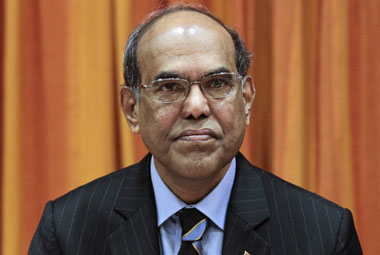RBI governor D Subbarao doesn’t like being predictable, it seems. At least, not too much.
While he met market expectations by keeping the keypolicy rate - repo rate - and the cash reserve ratio unchanged at 8.5 percent and 6 percent, respectively, he refused to offer any clues on when the bank would start cutting interest rates.
“I cannot speculate on the timing of the event,” a dapper-looking Subbarao told reporters. “I don’t know.”
[caption id=“attachment_158119” align=“alignleft” width=“380” caption=“For now, Subbarao is in wait-and-watch mode. Reuters”]  Governor Duvvuri Subbarao attends the monetary policy review meeting in Mumbai") [/caption]
The repo rate is the rate at which the central bank lends funds to commercial banks. The cash reserve ratio is the proportion of net deposits that banks must keep with the central bank as reserve.
For now, the markets will have to be content with just a small victory - no more painful rate hikes for now.
So why did the RBI keep interest rates on hold today?
Primarily for two reasons.One, growth is deteriorating. “This reflects the combined impact of several factors: the uncertain global environment, the cumulative impact of past monetary policy tightening and domestic policy uncertainties,” the RBI said in a statement.
Add to that global economic uncertainty. “Considering the global and domestic macroeconomic situation, the downside risks to the RBI’s growth projection, as set out in the second quarter review, have increased significantly,” the release said.
Two, inflation is moderating. Food inflation for the week ended 3 December fell to 4.35 percent, the lowest since February 2008, although headline inflation, represented by the wholesale price index, remains elevated at 9.11 percent for November.
Overall, the pace of price rises is falling. As the RBI noted, “the growth deceleration is contributing to a decline in inflation momentum, which is also being helped by softening food prices.”
Given the situation, the central bank decided that it was a good time to hold off on hiking interest rates for the 14th time since March 2010. In fact, it said that “from this point on, monetary policy actions are likely to reverse the cycle, responding to the risks to growth.”
That’s a big change in stance: most economists would call it moving from a ‘hawkish’ (aggressive, focused on taming inflation through interest rates) stance to a more ‘dovish’ one (more focused on promoting growth while still keeping an eye on inflation).
However, the transformation has only just begun, so don’t expect Subbarao to start flying with the doves yet.
In its statement, the central bank repeatedly cautioned that inflation risks remain high and could quickly recur as a result of both supply and demand forces.Indeed, inflation remains much above the comfort level of the RBI (5 percent).
And the risks to inflation continue: a falling rupee (which increases the cost of imports, especially oil); a worsening trade balance, expected hikes in power, fuel and aviation prices as well as a burgeoning fiscal deficit .
Clearly, it’s not yet time to forget about inflation. And Subbarao knows that. Of course, there is always the possibility that shrinking growth could lead to contracting prices and falling inflation domestically and globally.
For now, the pause in interest rates is very welcome.However, what the hobbled economy really needs is rate cuts to juice it up, which Subbarao can’t provide just yet. Blame that partly on the government, which has also failed to do its bit by improving the supply side to cool inflation.
In fact, the government is actually doing its bit to fuel inflation further by planning to increase expenditure on ill-timed schemes such as the Food Security Bill.
So, the beleaguered economy will continue to wheeze along, with no respite from high interest rates. The markets might be sorely disappointed, but Subbarao has valid reasons for not cutting rates just yet. With the government not doing anything on the economic policy front, and the RBI holding fire on interest rates, it will be a tough ride for the economy as it enters 2012.


)
)
)
)
)
)
)
)
)



